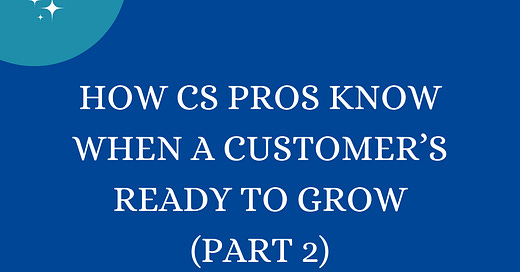✨How CS Pros Know When a Customer’s Ready to Grow (Part 2)✨
Customer expansion works best when it’s rooted in trust: first by helping customers realize value, then using relationships, insights, and timing to surface natural and relevant growth opportunities.
This week on Cracking The CS Code, I'm sharing the final part on how CS pros know when a customer is ready to grow, featuring insights from CS pros: Jomilsa S & Olivier Fiaty-Amenouvor. The last time, I shared the strategies of Raman Bindra (CS leader at Recruiterflow) and Pieter Boon.
This is what I learnt:
Customer expansion requires a strategic, relationship-driven approach, leveraging segmentation, goal mapping, and usage insights to identify the right moments to deliver added value
Expansion becomes a natural next step when you help customers first recognise the value they’ve already received, then connect their evolving needs to solutions you can offer.
Jomilsa
For Jomilsa, identifying expansion opportunities is a natural part of doing business, and it starts with nurturing the relationship you have with your customers. It’s not about pushing sales. It’s about understanding their journey, goals, and pain points so you can add real value.
Here’s how she approaches this, both internally and externally:
1. Internal Analysis: Prioritise by Potential
Jomilsa begins by segmenting customers based on their growth potential and current spend. This helps her prioritise and tailor her growth plans more effectively:
“For high-growth-potential but low-spend customers, I focus on ROI. I highlight how a deeper investment in our solution could accelerate their goals. I dig into their use cases and suggest solutions that align with their ambitions. The key here is to show how expansion leads to better outcomes, not just more features. I always lead with storytelling and real-life case studies.”
“For high-spend, low-growth customers, I focus on retention and engagement. I keep them close through community invites and position them as power users or collaborators. I also look for sideways expansions—like adding new users or teams—where it makes sense.”
2. Tie Expansion to Their Timeline
On every check-in call, Jomilsa makes it a point to understand her customers’ evolving short- and long-term goals and how those might be shifting:
“As I map their journey, I treat time-to-first-value, check-ins, and business reviews as natural moments to explore new opportunities. I ask open-ended questions like, ‘Now that you’ve achieved X, how can we support your next priority?’ These moments give me deep insight into what’s next for them.”
3. Monitor Product Usage: Trends & Triggers
Usage data is one of her most reliable signals for identifying growth potential:
“Increased usage can mean growing demand or a new pain point they’re trying to solve. That’s often my cue to start a conversation around how we can support them further.”
“On the other hand, decreased usage isn’t always a red flag it might mean the product solved a key issue. Either way, I use it as a moment to realign, explore new needs, and see how we can support them in new ways.”
4. Build Collaborative Growth
For Jomilsa, expansion happens best when customers feel like true partners:
“I invite them to user groups, webinars, and beta testing. I spotlight their wins and position them as industry champions. I’ve found that the more involved they feel, the more likely they are to become advocates and to grow with us.”
At the core of it all? Listening.
“By deeply understanding their challenges, preferences, and feedback, I’ve built trust that opens the door to smoother, more strategic expansion conversations—without the fear of cost or friction.”
Olivier Fiaty-Amenouvor
For Olivier, expansion begins with a single core belief: satisfied customers naturally expand.
“I always take a consultative approach when discussing expansion with my clients. Before they can even think about ‘buying more,’ they need to feel confident that their current investment is delivering value.
Once they validate it themselves, I ask where they’re hitting limitations or friction. As they share, I look for natural opportunities to connect their challenge to an additional feature or tool we offer—something they don’t currently use but could solve that exact issue and drive better outcomes.
The expansion happens right there, in the flow of the conversation. I’ve used this approach many times, and it always works.”
Final Thoughts
Jomisila and Olivier show that the most effective expansion strategies are rooted in trust, timing, and a deep understanding of customer goals. Whether it’s using usage signals and segmentation like Jomisila, or Olivier’s consultative conversations that surface unmet needs, both center the customer’s success first. How are you currently identifying expansion opportunities in your own customer relationships?





